Christof Lehmann (nsnbc) : The presence of Iranian commander Ali Qakarani accompanied by Iranian forces including some 30 or more bodyguards in the Yazidi town of Sinjar, northwest Iraq could suggest that Tehran has set its sights on Saddam’s former prime real estate for Scud missiles. The presence of Iranian troops or proxies has immediate consequences for the Yazidi, but the prospect of the placement of Iranian missiles on the Mount will have regional implications that put the Yazidi and the Kurds between a rock and a hard place.
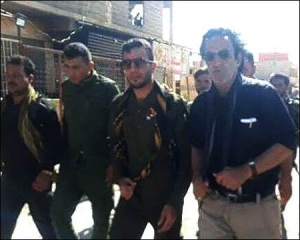
Iranian commander Ali Qakarani (right) in civilian clothes accompanied by Iranian forces including some 30 or more bodyguards on October 18, 2017 in the Yazidi town of Sinjar, northwest Iraq.
Iranian Commander Ali Qarkarani spotted in Sinjar
Kurdish officials Ali Qarkarani in civilian clothes accompanied by Iranian forces including some 30 or more bodyguards on October 18, 2017 in the Yazidi town of Sinjar, northwest Iraq.
Qarkarani and his delegation visited the strategically extremely sensitive region after the independence referendum in Iraq’s Kurdistan Autonomous Region (KAR) and as forces of the Iraqi, Shia-dominated military and Iranian-backed Popular Mobilization Forces (PMU) a.k.a. al Hashd al-Shaabi gained control of Kirkuk and other strategic areas, disputed claimed by both Baghdad and the Kurdistan Autonomous Region.
The visit of Ali Qarkarani and the Iranian delegation came also against the backdrop of significant progress made by the predominantly Syrian – Kurdish, U.S.-backed Syrian Democratic Forces (SDF) in northeastern Syria and especially, in Raqqa and Syria’s Deir Ez-Zor province. The presence of the Iranian delegation including Alo Qakarani in Sinjar and on Mount Shingal strongly suggests that Iran has set its sights on controlling the predominantly Yazidi region.
The presence of the Iranian commander also suggests that Iraq’s Yazidi (Yezidi) on Mount Shingal and in Sinjar have good reason to be concerned about continued oppression, now by Shiite militia instead of ISIS, and that Yazidi fighters who returned from Raqqa may not have the opportunity to enjoy peace for a very long time.
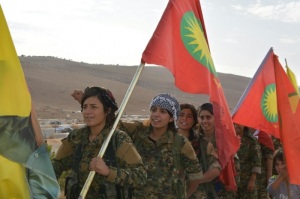 Shingal Women’s Units (YJS) returned from Raqqa in October
Shingal Women’s Units (YJS) returned from Raqqa in October
In late October, only days after Qarkarani and the Iranian delegation was spotted in Sinjar, fighters of the Shingal Women’s Units (YJS) who took part in the operation to liberate Raqqa, have returned home after four months of battle against Daesh gangs.
The returning female fighters from Shingal (Shengal) located in the Sinjar montains in Iraq near the Syrian border, who took part in the operation against the Islamic State in Raqqa, as party to theU.S.-backed Syrian Democratic Forces (SDF) were welcome home with enthusiasm.
Fighters speaking to their community stated “for Êzidî women, we took revenge from Daesh”. The people of Shengal welcomed their fighters at the Serdest Camp on the foothills of Mount Shengal.
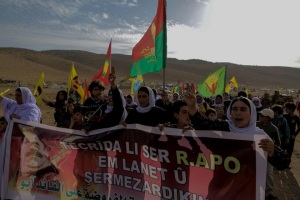 Later on, the people and the fighters drew attention to the health conditions of Kurdish People’s Leader Abdullah Öcalan by chanting slogans as they walked to a tent that was built up for this purpose. One of the YJŞ fighters named Tekoşin shared her feelings with us in front of the camera as such:
Later on, the people and the fighters drew attention to the health conditions of Kurdish People’s Leader Abdullah Öcalan by chanting slogans as they walked to a tent that was built up for this purpose. One of the YJŞ fighters named Tekoşin shared her feelings with us in front of the camera as such:
“Turning back to Shengal after four months of battle fills us with joy. The people welcomed us with huge enthusiasm at a tent dedicated to the Leader. And we dedicate the victory of Raqqa first of all to our leader, to our martyrs and the Êzidî women that were taken as hostages by Daesh.”
YJS commander Dersim Baran stated that they fulfilled their duty in Raqqa and that they handed over the rescued hostages to the SDF. With their camp based at Mount Shingal and at the Iraqi – Syrian boder, however, the YJS may not have much time to enjoy peace.
The Yazidi’s uncertain future between a rock and a hard place
In September 2017 YAZDA released a report entitled “AN UNCERTAIN FUTURE FOR YAZIDIS: A REPORT MARKING THREE YEARS OF AN ONGOING GENOCIDE“. The report also stressed the potential for conflict with Yazidi being caught in the middle of conflicting interests stating:
The PMU (Popular Mobilization Units a.k.a. Hash al-Shaabi) is the second most influential force in Sinjar and the principal political presence in southern Sinjar. The PMU controls a swathe of land along the Iraq-Syria border and most of Nineveh Province. The two most prominent groups of the PMU in Sinjar are Kata’ib al-Imam Ali (the Imam Ali Battalions) and the Badar Organization. The PMU is said to be under the authority of Deputy Commander, Mahdi al Muhandis. Its presence has drawn further Turkish interests into Sinjar and created a potentially combustible situation with the PDK, as the latter reportedly perceives PMU as its ‘next generation’ enemy.
However, Yazidi are also aiming to assert themselves within the Hashd al-Shaabi. The report notes among others that:
The PMU in Sinjar comprises mostly Shi’a fighters from different brigades. However, a new Yazidi force is being established and is currently made up of approximately 2,000 Yazidi fighters under three organized battalions – Kocho, Lalish, and Ezidkhan. These are likely to increase in size in the coming months. A training base has been established in southern Sinjar to train Yazidi fighters in the battalions.
Two Yazidi commanders, Murad Shero and Naif Jaso, are the highest-ranking Yazidi leaders within the PMU. Other tribal leaders have also joined. Both the Yazidi Movement for Reform and Progress and the Yazidi Progress Party are supporting the CGI, the presence of the PMU forces and the Iraqi Military in Sinjar, but they oppose all Kurdish politics in Sinjar and all Yazidi areas. Some civil and independent groups as well as NGOs hold a similar position.
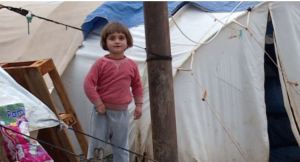 The report also noted that the PMU, at least according to its public statements, appears to conform with Yazidi objectives for the population in Sinjar. It has promised Yezidi self-rule for their areas; the formation of a force under Yazidi leadership; and the bringing to justice of all those who participated in the genocide.
The report also noted that the PMU, at least according to its public statements, appears to conform with Yazidi objectives for the population in Sinjar. It has promised Yezidi self-rule for their areas; the formation of a force under Yazidi leadership; and the bringing to justice of all those who participated in the genocide.
However, now that the Central Government of Iraq, with the help of Iranian – backed Shiite Hashd al-Shaabi, has pushed Kurdish Peshmerga out of Shingal again, it remains to be seen whether the Hashd (and by implication Tehran) will honor their promises, if the Central Government in Baghdad will honor its promises, or if Baghdad reverts to is culture and policy of oppression.
Finally, there is a risk of Yazidi infighting as different armed Yezidi organizations have different affiliations, some of them being allied with the PKK and YPG, others with other Iraqi Kurdish parties and groups, and yet others again with the Hashd or the central government.
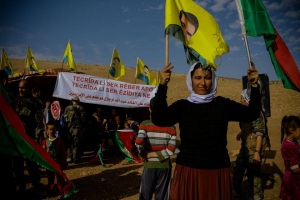 The YJS is solidly anchored in its alliance with the Kurdistan Worker’s Party (PKK), putting it at odds with Turkey, Iran, the Shia-dominated government in Bagdad, the Syrian Baath Party government in Damascus, as well as those Yazidi militia that joined the Hashd al-Shaabi.
The YJS is solidly anchored in its alliance with the Kurdistan Worker’s Party (PKK), putting it at odds with Turkey, Iran, the Shia-dominated government in Bagdad, the Syrian Baath Party government in Damascus, as well as those Yazidi militia that joined the Hashd al-Shaabi.
Yazidi communities are, in other words, caught in the middle of regional and geopolitical rivalries involving the Central Government of Iraq, the Shiite government in Iraq, the uncompromisingly anti-Kurdish and increasingly Islamist Sunni Turkey, various – including rivaling – Kurdish groups from Iraq, Iran, Syria, and Turkey, an increasingly Iranian-dominated Syria, as well as the UK, other EU member States, the USA and Russia.
The potential for a genocide and even an intra-Yazidi conflict is not only present; It constitutes an acute risk. Khairi Bozani, the head of the Yazidi Affairs Office of the Kurdistan Regional Government (KRG) in Iraq’s Kurdistan Autonomous Region (KRG) said in November 2017 the number of Yazidi survivors who were kidnapped by the Islamic State has reached up to 3,191. Bozani said around 90,000 Yazidi out of a total of 550,000 in Iraq have immigrated to Europe.
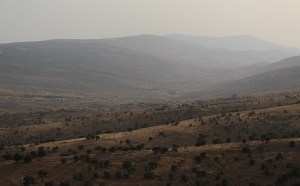 Presence of Iranian troops or proxies on Mount Shingal bound to have regional implications
Presence of Iranian troops or proxies on Mount Shingal bound to have regional implications
Iran’s apparent attempt to control Mount Shingal and the consequences of this attempt have far-reaching implications that put the Yazidi in the center of a potentially perfect storm. Mount Shingal was Saddam Hussein’s prime rea estate for Scud missile launches.
Any presence of Iranian troops or proxies with access to ballistic missiles on Mount Shingal or with the capability to move ballistic missiles there on short notice will invariably attract Israel’s and arguably also Washington’s undivided attention and put the Yazidi and Kurds between a rock and a hard place.
Kurds in Syria and Iraq, Turkey and Iran are aware of Mount Shingal’s strategic importance, including the fact that the placement of long-range artillery or short-to-medium-range missiles on Mount Shingal would give Tehran or its proxies great advantages with regard to controlling “rebellious Kurds” in Iraq’s Kurdistan Autonomous Region (KAR), including Iranian Kurds on the Iraq – Iran border, U.S.-backed Kurds in eastern Syria, and PKK and PKK allied Kurds on the Iraqi – Turkish border.
Syria, depending on Iran, is likely to find a consensus with Iraq, Iran, and even with Turkey, against those “rebellious Kurds” and the Yazidi are caught in the middle of an increasingly likely perfect storm. Turkey is bound to back Iranian policies, putting it even more at odds with Washington and the EU.
Prior to the Atlantic Council’s 2013 Summit in Ankara, Council President Frederik Kempe was quoted as saying that he is of the opinion, that a very important period has begun from the perspective of the United States, Turkey and Iran, saying: “We view the current period as a turning point, just like 1918 and 1945. Turkey is in every way a central country, as a creator of regional stability. However much the USA and Turkey can work in unison, that is how effective they will be.”
The implied takeaway message is that the arbitrarily drawn borders of the Middle East, imposed during the Ottoman period, the colonial period, Sykes – Picot, and post World War II have led to disaster and misery. A reorganization and a restructuring of the region – also one that breaks up artificially-constructed nation states – the creation of new constructs based on the sovereignty of people and their right to self-determination in the region could become the challenge of this century. One of the great questions will be “did we learn from the catastrophic wars that ended in 1918 and 1945 – and how will it be possible to achieve self-determination for Kurds, an end of the seemingly endless persecution and oppression of Yazidi and other people in the region without repeating catastrophic mistakes”.
CH/L – nsnbc 12.11.2017
Source Article from https://nsnbc.me/2017/11/12/87064/
 RSS Feed
RSS Feed















 November 12th, 2017
November 12th, 2017  Awake Goy
Awake Goy 










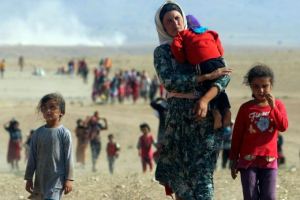

 Posted in
Posted in  Tags:
Tags: 













